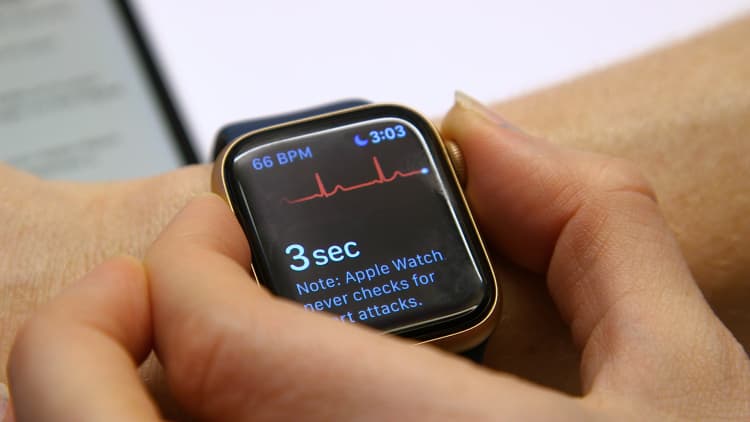Apple Watch users can now take a reading of their heart's electrical signal by holding a finger on the crown of the device.
On Thursday, customers with the Apple Watch Series 4 who install the latest software update can access a new feature to identify atrial fibrillation, a common form of an irregular heart rhythm, as well as opt in to more passive monitoring. Anyone over age 22 can use these new heart health features, although not all them are designed for people who have already been diagnosed with atrial fibrillation, or AFib, by their doctor.
All of this has been in the works for years. Apple got a first-of-its-kind clearance for its electrocardiogram app from federal regulators in September after conducting a preclinical study with 2,000 people. It also did a clinical trial with 600 other participants to ensure it could distinguish between a normal heartbeat, or sinus rhythm, and atrial fibrillation. The company released data on its new features in a white paper, published on Thursday, as well as a physician-facing website.
Ahead of the launch, I've been playing with the device all week and getting back information about my heart's rhythm that I've never seen before. Here's how you can do it, too:
How to check for an irregular rhythm
Once you install the latest software on your watch, migrate over to the Watch app on your iPhone. From there, scroll down to heart health and you'll see a new menu of options to enable a set of notifications for Apple to detect an irregular rhythm, and to view your ECG readings once you take them. (Apple calls the feature "ECG," although another common shorthand is "EKG.")
Let's start with irregular rhythm notifications, which don't require much effort to set up.
If you opt in, Apple Watch will check for an irregular rhythm about every two hours when you're at rest. It only notifies you if it spots an irregularity five consecutive times, as you won't want to rush to the emergency room over a software glitch.
The process begins by asking for a date of birth, presumably to ensure you're over age 22. It then provides some information about how it monitors you for atrial fibrillation:
You'll notice fairly quickly that Apple asks if you're already been diagnosed with the condition. If you have, the irregular rhythm feature is not for you. Apple doesn't want its device to be the primary monitoring tool for people who have a medical condition that puts them at a higher risk of strokes and other potentially fatal outcomes. Instead, it wants to help people who don't know they have it take the first step to get a diagnosis: About a quarter of the 2.3 million people who have atrial fibrillation won't experience any symptoms.
You'll then get a notification about everything that the Apple Watch does not do. It won't track heart attacks, help you get off meds or replace your doctor, among other things. Apple , but it clearly doesn't want users to make important medical decisions on their own.
Finally, you'll get some information about what to do if you are experiencing an irregular heart rhythm that might be atrial fibrillation. In short, see your doctor.
You can also set up high and low heart rate notifications to the parameters of your choosing. I'll receive an alert from Apple Watch if my heart rate falls to 40 beats per minute or as high as 120 beats per minute.
Taking an ECG
Taking an ECG measurement is also fairly easy.
First, set up the ECG app on the watch, which again requires a date of birth. Apple also provides some instructions on how to take a reading by placing a finger on the digital crown of the Apple Watch. You don't need to hold down on the crown, just touch it and stay still.
Apple then explains the different results users might get. The most common — and the reading I got every time I took an ECG — is "sinus rhythm." That basically means the heart is beating in a uniform pattern, and the Apple Watch hasn't detected an irregularity in your heart rhythm with its sensor. An important caveat: It doesn't screen for every condition, and you should still seek medical care if you're experiencing symptoms.
You might also see atrial fibrillation, low or high heart rate, or an inconclusive result, which might be because you moved around too much or you need to tighten your Apple Watch around the wrist. The ECG sensor incorporates new electrodes built into both the back crystal and the digital crown, which are designed to measure your heart's electrical signal if you're using the device correctly.
Once you're ready to take a reading with your Apple Watch, hold down a finger on the digital crown for 30 seconds. After that you'll get a result, and you can store it in the health app on the phone or share it in a PDF file with a doctor.
You can also add a symptom to the reading, like shortness of breath or dizziness.
I tried it about a half dozen times this week. Fortunately, I always got a sinus rhythm result.
But this feature isn't really intended to be used all day. You might only want to check if you're experiencing symptoms.
All in all, it was a more intuitive experience than I expected.
I could see it being a game changer for people who don't realize that something serious is wrong with them. Higher-risk patients tend to be older and have high blood pressure, a heart condition, a family history with atrial fibrillation or another medical problem. Apple will need to keep investing in reaching people in those demographics who need these features the most.
Please let us know what you think about these new Apple Watch health features. Reach out on @CNBCTech on Twitter.




